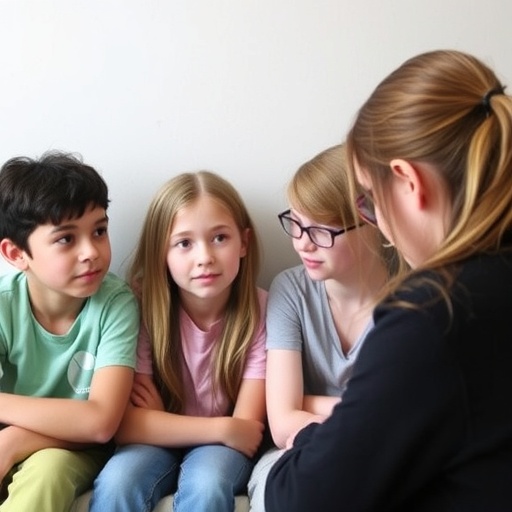In recent years, the relentless rise of bullying among adolescents has become a pressing concern for mental health professionals, educators, and policymakers alike. The profound impact of bullying victimization on adolescent mental health has spurred extensive research efforts aimed at not only understanding its consequences but also unraveling the intricate psychological pathways through which these effects manifest. A groundbreaking study published in BMC Psychology in 2025 offers an illuminating exploration into how parent-child relationships and self-esteem serve as crucial mediators in this dynamic, shedding new light on potential intervention strategies that could substantially mitigate the deleterious effects of bullying.
Bullying victimization refers to repeated aggressive behavior where there is an imbalance of power, often leaving the victim feeling helpless and isolated. Its prevalence during adolescence—a critical developmental period marked by identity formation and emotional maturation—renders its potential psychological consequences especially damaging. Previous research has predominantly focused on direct correlations between bullying and mental health outcomes, such as anxiety, depression, and suicidal ideation. However, the nuanced mechanisms through which bullying influences mental health have remained less clearly understood, impeding the formulation of targeted and effective interventions.
The recent study conducted by Li, Wu, Yao, and colleagues bridges this gap by emphasizing the roles of two pivotal psychosocial variables: the quality of the parent-child relationship and the adolescent’s self-esteem. These mediators elucidate the pathway from bullying victimization to mental health outcomes, suggesting that interventions targeting these domains could profoundly influence resilience and recovery trajectories in bullied youth. Parent-child relationships, characterized by warmth, trust, and open communication, emerge as a critical buffer against the negative psychological sequelae of bullying.
The methodology employed in this study involved extensive quantitative analyses of adolescent populations, utilizing validated psychological scales to assess bullying experiences, parent-child relationship quality, self-esteem levels, and mental health indicators. This robust data set enabled the researchers to deploy sophisticated statistical models to untangle the mediating effects within the bullying-mental health nexus. The implications are profound: enhancing parent-child bonds and fostering adolescent self-esteem may significantly alleviate the mental health burden imposed by bullying.
Understanding the parent-child dynamic is especially crucial given that parental support can provide emotional security and validation during tumultuous adolescence. In cases where bullying victimization undermines an adolescent’s psychological integrity, a secure and supportive relationship with caregivers acts as a psychological sanctuary. It validates the adolescent’s worth and counters the internalization of negative peer messages, which often precipitate depressive and anxious symptomatology.
Self-esteem, intrinsically linked to an adolescent’s perception of self-worth and competence, functions as both a protective factor and a potential point of vulnerability in the context of bullying. Victims frequently suffer diminished self-esteem, a core issue that exacerbates mental health difficulties. By delineating self-esteem’s mediating role, the study reveals that interventions focused on bolstering self-worth could disrupt the cascade of negative outcomes following bullying incidents, thereby fostering psychological resilience.
The interrelationships among bullying, parent-child relationships, and self-esteem highlight an intricate biopsychosocial model of adolescent mental health. This model acknowledges that bullying is not an isolated phenomenon but is intricately woven into the adolescent’s broader social and familial context. Therefore, any effective mental health intervention must adopt a multifaceted approach addressing this complexity.
Moreover, this study underscores the necessity for school-based mental health programs to collaborate with families, designing comprehensive frameworks that include parental engagement and psychoeducation. Such collaboration can enhance parental responsiveness to adolescent distress and equip families with tools to nurture self-esteem, thereby mitigating bullying’s harmful mental health effects.
Intriguingly, this research also calls for a reevaluation of existing anti-bullying policies. Traditional punitive approaches directed solely at perpetrators often overlook the silent suffering of victims and the psychosocial contexts that influence bullying dynamics. Integrating family-centered strategies and psychological support into policy frameworks could engender more sustainable and meaningful outcomes.
From a neuroscientific perspective, the results also correlate with emerging evidence indicating that adverse social experiences during adolescence, including bullying, can alter neurodevelopmental pathways involved in emotion regulation and stress responsiveness. The buffering roles of supportive parents and high self-esteem might counteract these neurobiological alterations, highlighting the neuroplastic potential of psychosocial interventions during adolescence.
Future research avenues should continue to explore longitudinal trajectories of bullied adolescents, specifically examining how fluctuations in parent-child relationship quality and self-esteem over time influence mental health outcomes. Understanding these temporal dynamics can further refine intervention timing and personalization, maximizing therapeutic efficacy.
Furthermore, the study highlights the potential benefits of integrating digital therapeutic technologies aimed at enhancing self-esteem and fostering positive family communication patterns. As adolescent interactions increasingly shift toward digital realms, leveraging these tools could prove vital in delivering scalable, accessible mental health support.
In conclusion, the 2025 study by Li and colleagues fundamentally advances our understanding of the mechanisms that mediate the relationship between bullying victimization and adolescent mental health. By elucidating the critical, intertwined roles of parent-child relationships and self-esteem, it paves the way for holistic intervention paradigms that not only address the immediate impacts of bullying but also empower adolescents with enduring psychological resources. Such insights are indispensable as society continues to grapple with the multifaceted challenge of adolescent bullying and mental health.
Subject of Research:
Bullying victimization and its impact on adolescent mental health, focusing on the mediating effects of parent-child relationships and self-esteem.
Article Title:
Bullying victimization and adolescent mental health: the mediating roles of parent-child relationship and self-esteem.
Article References:
Li, J., Wu, Y., Yao, M. et al. Bullying victimization and adolescent mental health: the mediating roles of parent-child relationship and self-esteem. BMC Psychol (2025). https://doi.org/10.1186/s40359-025-03723-8
Image Credits: AI Generated




